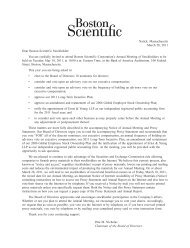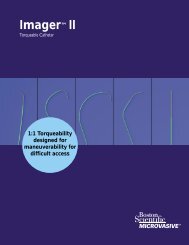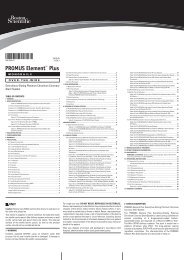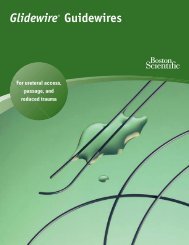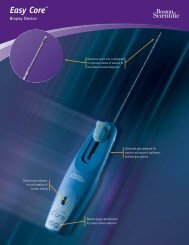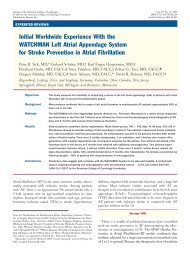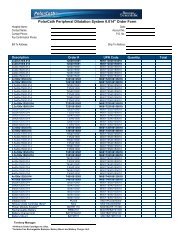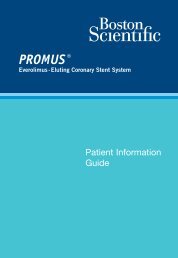CONSOLIDATED FINANCIAL STATEMENTS - Boston Scientific
CONSOLIDATED FINANCIAL STATEMENTS - Boston Scientific
CONSOLIDATED FINANCIAL STATEMENTS - Boston Scientific
You also want an ePaper? Increase the reach of your titles
YUMPU automatically turns print PDFs into web optimized ePapers that Google loves.
MANAGEMENT’S DISCUSSION AND ANALYSIS of financial condition and results of operations<br />
EMT’s ENTERYX ® Liquid Polymer Technology and Smart’s atherosclerosis<br />
stent, which collectively represented 82 percent of our<br />
2002 acquired in-process projects’ value. ENTERYX is a patented liquid<br />
polymer for the treatment of gastroesophageal reflux disease<br />
symptoms. During 2003, we completed the ENTERYX in-process<br />
project and received FDA approval for this technology. The total<br />
cost for us to complete the project was $6 million. The atherosclerosis<br />
stent is a self-expanding nitinol stent designed to treat<br />
narrowing of the arteries around the brain. We continue to pursue the<br />
development of Smart’s atherosclerosis stent and believe we have a<br />
reasonable chance of completing the project. We have spent $7 million<br />
on this project as of December 31, 2004 and estimate additional<br />
costs of $1 million to complete the project. These estimates approximate<br />
our estimates at the time of acquisition.<br />
OUTLOOK<br />
In 2004, we increased our net sales by 62 percent, our reported net<br />
income by 125 percent and our cash provided by operating activities<br />
by 129 percent. This growth was primarily due to sales of our TAXUS<br />
stent system that was approved for sale in the U.S. on March 4, 2004.<br />
We estimate that the worldwide coronary stent market will exceed<br />
$5 billion in 2005 and approximate $6 billion in 2006. Historically, the<br />
worldwide coronary stent market has been dynamic and highly competitive<br />
with significant market share volatility. Drug-eluting stents are<br />
estimated to represent approximately 87 percent of the worldwide<br />
coronary stent market in 2005 and approximately 90 percent in 2006.<br />
Our drug-eluting stent system is currently one of only two drug-eluting<br />
products in the U.S. market and there is uncertainty regarding the<br />
timing of new entrants into that market. We believe that we can<br />
maintain our leadership position within the drug-eluting stent market<br />
for a variety of reasons, including:<br />
• the positive and consistent results of our TAXUS clinical trials;<br />
• the performance benefits of our current technology;<br />
• the strength of our pipeline of drug-eluting stent products and the<br />
planned launch sequence of these products;<br />
• our overall market leadership in interventional medicine and our<br />
sizeable interventional cardiology sales force; and<br />
• our significant investments in our sales, clinical, marketing and<br />
manufacturing capabilities.<br />
However, a material decline in our drug-eluting stent revenue would<br />
have a significant adverse impact on our future operating results. The<br />
most significant variables that may impact the size of the drug-eluting<br />
coronary stent market and our position within this market include:<br />
• unexpected variations in clinical results or product performance of<br />
our and our competition’s products;<br />
7<br />
• the timing of new competitive launches;<br />
• the average selling prices of drug-eluting stent systems;<br />
• delayed or limited regulatory approvals and reimbursement policies;<br />
• litigation related to intellectual property;<br />
• continued physician confidence in our technology;<br />
• the average number of stents used per procedure;<br />
• expansion of indications for use; and<br />
• the international adoption rate of drug-eluting stent technology.<br />
We recently announced nine-month results from our TAXUS V clinical<br />
trial. TAXUS V expands on the TAXUS IV pivotal trial by studying a<br />
higher-risk patient population, including patients with small vessels,<br />
large vessels and long lesions requiring multiple overlapping stents.<br />
The overall TAXUS V study met its primary endpoint of safety and<br />
efficacy as well as all secondary endpoints. In addition, stent thrombosis<br />
rates were virtually identical between the TAXUS stent and baremetal<br />
stents indicating comparable safety of drug-eluting stents and<br />
bare-metal stents. However, inconsistent clinical data from existing or<br />
future trials conducted by us, by our competitors or by third parties<br />
may impact our position in and share of the drug-eluting stent market.<br />
Our drug-eluting stent system is currently one of only two drug-eluting<br />
products in the U.S. market. We expect our share of the drug-eluting<br />
stent market as well as unit prices to be adversely impacted as<br />
additional competitors enter the drug-eluting stent market, which we<br />
anticipate during 2005 internationally and during 2006 in the U.S.<br />
During the first quarter of 2005, we completed our initial launch of our<br />
next-generation drug-eluting stent product, the TAXUS Liberté coronary<br />
stent system, in certain Inter-Continental markets. We expect to<br />
launch the TAXUS Liberté coronary stent system in Europe during<br />
2005 and in the U.S. during 2006, subject to regulatory approval. In<br />
2004, Johnson & Johnson announced its intention to acquire Guidant<br />
Corporation (Guidant). Johnson & Johnson and Guidant are two of our<br />
primary competitors in the coronary stent market and this acquisition<br />
may create increased volatility and uncertainty within the coronary<br />
stent market.<br />
In addition, during the second quarter of 2004, one of our competitors<br />
launched its drug-eluting stent in Japan, which has converted rapidly<br />
to drug-eluting stent technology. In order to receive regulatory approval<br />
of the TAXUS stent system in Japan, we were required during 2004<br />
to conduct a small clinical trial using the TAXUS stent system with the<br />
antiplatelet therapy Ticlid ® . We currently expect to launch the TAXUS<br />
stent system in Japan late in 2006, subject to regulatory approval.<br />
Due to the timing of regulatory approval for our TAXUS stent system<br />
and recent government-mandated, industry-wide pricing reductions<br />
for medical devices in Japan, we believe that our operating income<br />
BOSTON SCIENTIFIC AND SUBSIDIARIES



